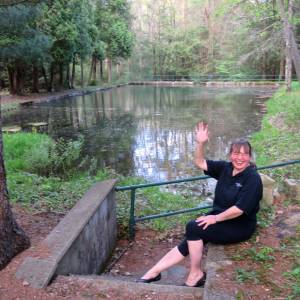Portrait of a Milkweed Obsession
I have an admission to make: I have a new obsession and you're looking right at it! Yes, the floof (or fluff, or floss) of the common milkweed pod. This is the time of year that the pods break open and the seeds go on journeys EVERYwhere, floating along on the winds.
For the past few weeks, I've been taking lots of pictures of milkweed pods and floss. I'm sorry this is the first one you got to see. There have been lots of other ones along the way, but somehow they never made it to the daily blip posting. Until now!
On Saturday, my husband and I walked up the hill to the gameland, and I spotted a stand of milkweed along the road. The floss was shining like angel hair in the sun, and I photographed the plants, and made note to myself to snap off a few pods on the return trip, which I did.
My plan was two-fold: to have some fun photographing the floss and seeds (done!), and then to plant the seeds around our yard so that we might increase the amount of native milkweed for the monarchs next year (not done yet - I'm just having too much fun playing with the floss!).
Milkweed is a critical plant in the butterfly ecosystem. It is the plant whose leaves a monarch caterpillar chomps away on until it forms a chrysalis and turns into a gorgeous butterfly. The whole process is an amazing miracle to witness.
This past summer, we had just a few milkweed plants in our yard, and we watched with amazement as about a half-dozen monarch caterpillars appeared. They grew fat, and as the milkweed leaves disappeared, my husband and I brought them more.
Then one day - just like they said would happen! - we spotted a green chrysalis. About nine days later, the chrysalis turned very dark and clear, and the next day, a gorgeous butterfly emerged, dried its wings, and flew away!
Needless to say, we were delighted to be part of it all, even in just a tiny way. I do have a butterfly garden along the side of the house but alas, it does not contain any milkweed. (A good butterfly garden should have a variety of both host and nectar plants - host plants for the caterpillars and nectar plants for the adult butterflies.)
So my goal in the coming year is to improve the diversity our yard as wildlife habitat by planting more milkweed. :-) For the butterflies, you know. But also for me, the lover of milkweed floss!
Oh, and by the way, did you know this interesting historical tidbit? In World War II, the supply of kapok, the substance used to fill life vests, was cut off by the Japanese. It was discovered that milkweed floss - many times more buoyant than cork - could be used as a substitute.
The Christian Science Monitor website provides this quote:
So wartime pamphlets encouraged children to gather milkweed. A brochure produced by the Soil Conservation Service for War Hemp Industries urged: “School children of America! Help save your father’s, brothers’, and neighbors’ lives by collecting milkweed pods.”
So there you have it. A bit of fun and some historic trivia to boot! In this photo, I was holding the pods in my left hand and brandishing my camera with my right. I was trying to position the silky floss directly between myself and the afternoon light, for maximum effect. (By the way, you may see another fun take on this concept in the EXTRA to this blip.)
As I was holding my milkweed pods in the air, a little breeze was blowing, and the milkweed seeds were trying their best to fly away and escape. Do you see that very independent looking seed on the lower left?
After this shot, that little seed cried "FREEDOM!!!!!" and it leapt bravely into the wind, to begin its own journey either nearby or even possibly far away. So the song to accompany this image is the title track from Journey's 1981 album, Escape, some of whose lyrics appear below.
I've got dreams I'm livin' for
I'm movin' on where they'll never find me
Rollin' on to anywhere
I'll break away, yes I'm on my way
Leavin' today, yes I'm on my way

Comments
Sign in or get an account to comment.


